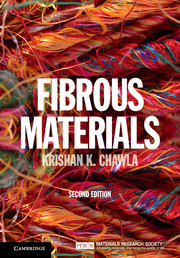Book contents
- Frontmatter
- Dedication
- Contents
- Preface to the Second Edition
- Preface to the First Edition
- Acknowledgments
- 1 Introduction
- 2 Fibers and fibrous products
- 3 Natural polymeric fibers
- 4 Synthetic polymeric fibers
- 5 Electrospun fibers
- 6 Metallic fibers
- 7 Ceramic fibers
- 8 Glass fibers
- 9 Carbon fibers
- 10 Experimental determination of fiber properties
- 11 Statistical treatment of fiber strength
- Appendix: Some important units and conversion factors
- Indexes
- Plate section
- References
3 - Natural polymeric fibers
Published online by Cambridge University Press: 05 June 2016
- Frontmatter
- Dedication
- Contents
- Preface to the Second Edition
- Preface to the First Edition
- Acknowledgments
- 1 Introduction
- 2 Fibers and fibrous products
- 3 Natural polymeric fibers
- 4 Synthetic polymeric fibers
- 5 Electrospun fibers
- 6 Metallic fibers
- 7 Ceramic fibers
- 8 Glass fibers
- 9 Carbon fibers
- 10 Experimental determination of fiber properties
- 11 Statistical treatment of fiber strength
- Appendix: Some important units and conversion factors
- Indexes
- Plate section
- References
Summary
Commercially, polymeric fibers are perhaps the most important of all; in terms of production volume as well as the vast range of applications. There are two broad categories of polymeric fibers: natural and synthetic. Natural fibers can be from the vegetable kingdom such as cotton, sisal, jute or from the animal kingdom such as wool, silk, etc. Natural fibers are mostly polymeric in nature. There are, however, some natural fibers that occur in rock formations. These fibers are minerals and can, therefore, be treated as a ceramic, e.g., asbestos and basalt. We describe these natural mineral fibers in Chapter 7. In this and Chapter 4, we describe polymeric fibers. In this chapter, we first briefly review some of the fundamental aspects of polymers and then describe the natural polymeric fibers. We devote Chapter 4 to the synthetic polymeric fibers, which have seen a tremendous advancement in the last half of the twentieth century. A vast range of natural polymeric fibers is available and they find large scale commercial applications. Much research effort, however, is focused on a very special natural fiber originating in the animal kingdom, spidersilk. The idea here is to learn about the processing, structure, and properties of silk fibers, especially spidersilk fibers, which are very strong and stiff. More about silk fiber later in this chapter. The volume of other natural fibers such cotton, jute, sisal, ramie, etc. in industrial and nonindustrial applications has always been quite large because of their many attributes such as the wear-comfort of cotton and the fact that all natural fibers represent a renewable resource. The main disadvantage of natural fibers is the immense variability in their physical, chemical, and mechanical attributes.
First, in order to understand the processing, structure, and properties of polymeric fibers, the main focus of Chapters 3 and 4, it will be useful to review some general and basic concepts regarding the structure of polymeric materials, and especially some of the important features associated with the macromolecular chains that do not have their counterparts in metals and ceramics. Readers more versed in these aspects of polymers may skip straight to Section 3.2. In what follows, we first examine the salient structural aspects of polymers and then describe the processing, structure, and properties of some important natural polymeric fibers.
- Type
- Chapter
- Information
- Fibrous Materials , pp. 42 - 68Publisher: Cambridge University PressPrint publication year: 2016



